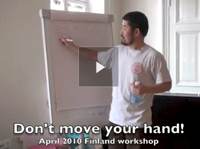 Taiji can certainly be considered a form of specialized technology, and like any specialized technology, this requires special language.
Taiji can certainly be considered a form of specialized technology, and like any specialized technology, this requires special language.
That language is something we have to be very careful of because, in many cases, a word with a ‘common’ meaning often has a special, more extensive, or more precise meaning than the one we would normally attribute to it.
Like everything in Taiji, understanding the true meaning requires training, but listening carefully to how Master Chen uses certain words is always instructive of how to train more correctly. “Adjust” is one such word we need to pay special attention to.
adjust ; alter or move (something) slightly in order to achieve the desired fit, appearance, or result.
In Taiji, ‘adjust’ is not a ‘movement’, but is the result of maintaining the correct relationship between moving and non moving parts.
Here is a portion of an interview with Master Chen conducted by John Brown, published in Tai Chi Magazine…
Q. When you bring in the concept of the dantian, are you saying the kua is rotating on each side and the ball is staying centered?
CZH> Whatever the intended activity of the upper body may be, rotations of the two kua are coordinated so as to ensure the trunk sitting on top of them remains erect all the time. How you do that each time varies, but the trunk must remain level, erect, and suspended.
Q. It seems that the functional role of the abdominal area just above the kua, the dantian or whatever, this includes the whole waist?
CZH> Yes
Q. So the waist really isnt moving, its not moving up and down and not moving left and right. Its staying in one place like a ball sitting on top of these two rotating balls under it?
CZH> I can give you a better word. Its called adjusting, not moving. The dantian area adjusts to the movement or the actions of the kua area, driven by the knees. At the same time, the dantian area can adjust to other movement, such as the shoulders being pushed or pulled by your opponent. In any case, dantian doesn’t cause action. It adjusts to actions applied on to it.
Q. Would you also say it is the point in the center of the body that maintains that uprightness and equilibrium?
CZH> Yes, it maintains and it adjusts. It does not create action. But for most practitioners, due to incorrect understanding, they attempt to create the action from the waist
Here is further instruction from “30 Chapters of Gold”
— Chen Zhonghua ( demonstration of a type of movement ) ” the movement of the finger is called “adjust”… ” adjustment ” is done in a way that you are unconscious of it. You do not ‘know’. What it does is that you can never be ‘off’… because if you don’t ‘move’ it, it ” adjusts “… If you ‘move’ it [ yourself ], you can never move it the right way. Can you understand what I said? This is the secret of Taiji. Seriously. Whenever you ‘move’ it you can never be precise, you can never be right, you can never be fast enough, you can never be accurate…. If you ‘don’t move’ it, the adjustment itself is forever, automatically, always right. So that is why I always tell you ‘ Don’t Move ‘, because the body will ‘ adjust ‘….


